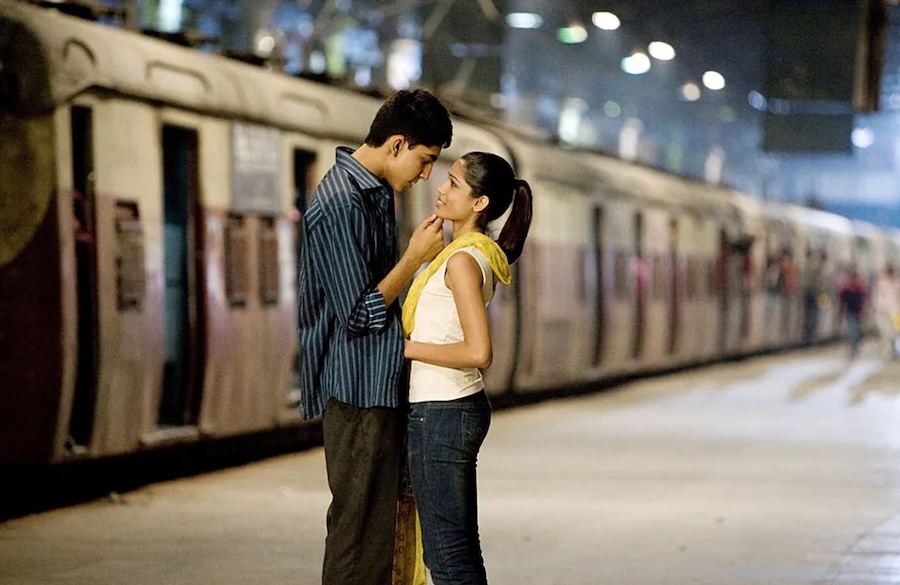
LOVE AND MONEY… YOU HAVE MIXED THEM BOTH.

A mass of energy. That’s what screenwriter Simon Beaufoy claims to have picked up from his meetings with street children in India, a journey he made to learn more about their situation before adapting Vikas Swarup’s novel. When Danny Boyle was hired to direct the film one thing was certain – that energy would be turned into visuals. Throughout his career, Boyle has over and over again proven that he can handle all kinds of genres and make the movies look anything but bland.
Winning 10 million rupees
The film begins in Mumbai, 2006. Jamal Malik (Dev Patel), a simple “chai-wallah” at a call center, whose primary task is to serve tea, has just won 10 million rupees on Who Wants to Be a Millionaire. He’s suspected of cheating and the local police decides to interrogate Jamal; after a failed attempt to torture the young man, the police inspector (Irrfan Khan) begins to listen to Jamal’s story. He grew up together with his brother Salim in the Mumbai slums; they also befriended an orphan girl, Latika. Life was tough for them already at this stage, but everything changed on the day they ended up in Maman’s (Ankur Vikal) company. He was a local, charismatic gangster who knew how to make friends with children and then exploit them in the cruelest way possible.
Jamal and Salim subsequently escaped from Maman, but Salim purposely left Latika behind. Jamal couldn’t forget the girl and found further reason to distance himself from his greedy brother…
Easy to be swept along
Because of its connection to the Who Wants to Be a Millionaire concept, Boyle wasn’t sure he wanted to make this picture. Understandable, perhaps, but Anil Kapoor’s performance makes a difference; he’s excellent as the host who grew up in the slums but made his way into the big time and now utterly despises anyone who tries to follow his example. The game show is presented here as cynical and vulgar with Jamal as the only point of decency, but it is also intended to symbolize the dream of success; all of India watches the show and roots for the poor call-center worker. They need him to win those millions, because if he can do it, so can they.
It’s easy to be swept along by the passion of the storytelling.
Boyle contrasts that dream with what might seem like success in the slums; gangsters making money off of their criminal enterprises. There is no satisfactory economic solution to the problems here, but the filmmakers seem reluctant to address that; they want you to be seduced by the emotional content. It’s easy to be swept along by the passion of the storytelling; cinematographer Anthony Dod Mantle’s sunbaked visuals; A.R. Rahman’s pulsating ethno score; and the positive outcome of Jamal and Latika’s love story. Still, it would have been interesting to see some kind of deeper analysis – and that’s also what more than a few Indian critics thought.
The story does have plenty of interesting ingredients though. The real-life street children who portray young Latika and Salim are absolutely perfect, and Salim trying to balance the love for his brother and money is a particularly engaging part. The cast is fine, even if Patel and Pinto’s performances aren’t among the film’s most compelling.
I found it baffling to see Slumdog Millionaire so universally hailed in spite of its flaws… but I also realize that most of my grievances concern ingredients that could have been part of the film instead of what is actually there. In the end, it’s undeniable that I enjoyed the movie, its clever structure, homage to Bollywood, and Boyle’s bag of seductive tricks.
Slumdog Millionaire 2008-U.K.-U.S. 120 min. Color. Widescreen. Directed by Danny Boyle. Screenplay: Simon Beaufoy. Novel: Vikas Swarup (“Q & A”). Cinematography: Anthony Dod Mantle. Music: A.R. Rahman. Songs: “Jai Ho” (A.R. Rahman, Sampooran Singh Gulzar), “O Saya” (A.R. Rahman, Maya Arulpragasam). Editing: Chris Dickens. Cast: Dev Patel (Jamal Malik), Freida Pinto (Latika), Madhur Mittal (Salim), Anil Kapoor, Irrfan Khan, Tanay Hemant Chheda.
Trivia: During the Indian shoot, Loveleen Tandan co-directed scenes; a campaign was subsequently launched to have her recognized for the awards season as equal to Boyle, but she and producer Christian Colson spoke out against it.
Oscars: Best Picture, Director, Adapted Screenplay, Cinematography, Editing, Original Score, Original Song (“Jai Ho”), Sound Mixing. BAFTA: Best Film, Director, Adapted Screenplay, Cinematography, Editing, Music, Sound. Golden Globes: Best Motion Picture (Drama), Director, Screenplay, Original Score. European Film Awards: Best Cinematography.
Last word: “I watched [Who Wants to Be a Millionaire] on TV. I’m not addicted to it now, but when it first came out in the U.K. I was addicted to it like everybody. It was like so compulsive. But I thought, ‘I don’t want to make a film about that.’ And the only reason I read [the script] was because the guy’s name who’d adapted it I noticed. I didn’t know him but he’d written The Full Monty, which is one of my favorite kind of films really. So I thought, ‘Well, I should really read a bit of it,’ so that when I talk to him, I could ring him up and say I enjoyed the script. I can sort of pretend I’d read it all. But I read it and I was like, that was the first time I knew it was set in India, reading it, and it was an absolutely extraordinary experience. And 10, 15 pages in I was lost in the story.” (Boyle, About.com)
